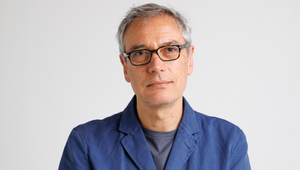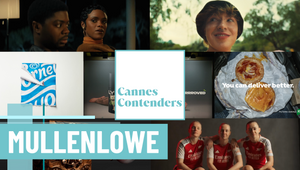
Isak Åkerlund: “The Abilities You Possess as an Artist and Designer are Very Powerful Tools. Use Them Wisely”

The MullenLowe NOVA Awards are gearing up for their tenth anniversary this month – and so they’ve invited their first ever winner, Isak Åkerlund. The award, in partnership with Central Saint Martins, platforms fresh creative talent, innovative thinking and exceptional executions.
Isak was awarded for his Henri Rousseau-inspired animated film ‘The Art of Darkness’, which imagined a tiger loose in a highly stylised, graphic London. Since then, Isak has set up his own studio and worked on a range of creative projects, from graphic design and art direction to product design (including designing for iconic Swedish toy brand BRIO).
LBB’s Laura Swinton caught up with Isak to find out about this year’s judging and how the landscape has changed for aspiring creatives, artists and designers.
LBB> What are your memories of the first MullenLowe NOVA Awards?
Isak> I have very warm memories from it. I received the inaugural MullenLowe NOVA Award, and it was totally unexpected for me. It fell from the sky, so to speak. The surprise of it all made it extra fun.
The ceremony was in the Lethaby gallery that had just opened. I finished my course in the beginning of the summer and the award ceremony was towards the end. During that time Central Saint Martins had changed location and moved into the new site at Kings Cross. The prize ceremony felt like a combined opening party for the new building and a birthday celebration for the MullenLowe NOVA Award. It was like the perfect finale of my own time at Saint Martins. It was surreal almost, like I was in a college movie or something. I graduated. There was a big party. I received an award out of the blue. I got a big check. There were free drinks and a great DJ. Everybody danced. It was a good evening. I was very happy!
LBB> What impact did it have on your confidence as you started your career?
Isak> It meant a lot to me. It was a great help for me in the beginning of my professional career as a designer and animator. I had put my heart into my graduation project, so in that sense the award felt more personal. And since the award was a complete surprise for me it was a confidence boost to get that recognition for a piece of work that I had put so much of myself into.
LBB> Tell us about what you’ve been up to creatively over the past ten years!
Isak> I started my own studio after graduation. As a freelance designer I have done a lot of different types of projects, mainly within the fields of product design, graphic design, illustration, art direction and animation. I have had a long-term creative collaboration as a lead designer for the classic Swedish toy brand BRIO. The outdoor brand SILVA is another company I have designed many products for. I have also been a lecturer in design and animation. At one stage I was working a lot with small start-up companies. I have also had collaborations with commercial studios as a concept sketch artist. In recent years I have turned more towards working for the health and rescue sector.
In between commissioned work I have tried to develop my own creative practice with more experimental artistic projects in my studio, just for the fun of it. But I never seem to have as much time as I would like for this.
LBB> We love your NOVA Award-winning film, ‘The Art of Darkness’ – how it explores the storytelling potential of art and design language. What are your memories of developing the idea and what were you trying to explore with the film?
Isak> I had so much fun when I worked with the development of the film. I had decided before I even started on the story that it would be an “all-visual” film. No dialogue, no voice over, no text at all. I wanted to rely completely on a visual language and aimed to make the most of an image-based storytelling.
The film was made in collaboration with the National Gallery and inspired by the painting “Surprise!” by Henri Rousseau. I like this painting a lot. The naïve painting style, the flatness of the composition and the tiger in the centre of the image that looks completely crazy. The expression in the tiger’s face is as ambiguous as the Mona Lisa to me. Is it happy, is it angry, is it sad? The creative process began in the painting.
‘I am going to release this Tiger on the streets of London and see what happens.’ That was the opening idea for the storyline.
I did a lot of character development sketching. The ideas came to me while I was drawing. I like that process of thinking with a pen. Rousseau painted the tiger´s tail in an unnaturalistic, quite graphical way. I developed this graphic looking Tiger in my sketches and striped it almost like a classic convict’s suite in black and white. I came up with the idea that the Tiger would trick its followers by using its camouflage like an optical illusion. A visual joke. I love classic hand drawn cartoons; they have a lot of gags that are pure visual humour.
I put a lot of effort into exploring the movements for the different characters. I wanted the movements of the figures to reflect their personality or lack of personality. I did a lot of research and studied real tigers to make the movement of my Tiger naturalistic, smooth, fluent and beautiful. The characters that hunt the Tiger on the other hand had the opposite kind of body language - mechanical and linear. In my development drawings those characters unfolded like Swiss army knives, all made in metal and with sharp extremities. I wanted to make them look scary but also silly, with an on/off, black/white kind of mind. I put them standing on the top of their toes, balancing on the edge of a knife, like evil ballerinas.
The intention was to make the film visually interesting and amusing to watch, funny like a cartoon, but with a very dark and serious underlying theme. I wanted to investigate the relationship between human nature and the Tiger´s spirit. There is something incredibly dark within the human mind that seem to want to conquer and control all other animals and nature itself. The final image of the film came to me like a sad dream. I saw the painting without the tiger in the centre. The wild tigers on our planet have been hunted to the brink of extinction. It is almost unbearable to think about. The horror of that. The title is an allusion to Joseph Conrad’s classic short novel “Heart of Darkness”.
My film is a celebration to the some of the things I love the most in life. Art. Cats. Nature.
LBB> Having moved forward with your design and animation career, do you still look back fondly on the film?
Isak> Yes, I think the film will always have a special place in my heart. There are a lot of things that could have been better when you look back of course. I was new to animation and to the software I was working with, so I was struggling to master all these new tools. The whole film is basically built up by one walk-cycle and one run-cycle. I would have loved to put more work into the animation. I also had ideas for a lot of more scenes that I never had time to develop. In my opinion the film was only half finished. I had an idea of keep working on it after my graduation, but I never got that opportunity. And now it doesn´t matter. Making the film was a learning experience. For me it was a project where the journey was more important than the final result. I look back fondly on the whole process. I really enjoyed making it. It was amazing to be able to create my own animated film!
LBB> What was your response to being invited to come back to judge?
Isak> I was very honoured and happy to be invited as a judge. It was an opportunity for me to reconnect to Central Saint Martins and to the MullenLowe NOVA Awards. I have been away for a long time now, so it was great to come back! I had a such a wonderful time in London and at Central Saint Martins, so the invitation was like a ticket down memory lane. But the best thing with the judging has not been my own nostalgia, it has been to see all the great work created by the students. It has also been an interesting experience to be on the other side of the table as a judge as I haven’t done that before.
LBB> How do you think the MullenLowe NOVA Awards have evolved since you were a student?
Isak> I think that the award is much more established now. It has the strength of a tradition at the same time as it is reinventing itself each year with new emerging talent and new graduates with fresh ideas and fascinating projects. When I received the award, it was brand new. Now it feels like the award has become a yearly highlight, a great celebration of creativity and the graduating students at Central Saint Martins.
I think the MullenLowe NOVA Awards are a great initiative to support emerging talent. I feel proud to be a small part of something that is constantly evolving, something much greater than myself. It feels like I have a connection to future generations of designer and artists. It is fantastic with an award that is dedicated to support students in the creative field and help them in their first steps of their professional career.
LBB> The world has changed a lot too, in ten years – what advice would you give to the students as they embark on their own creative careers in this very different landscape?
Isak> Yes, the world has indeed changed a lot. It is crazy really. To embark into a creative career is always a bit tricky compared to other professional routes, and even more so now. You must be creative in your work, but also be just as creative in how to navigate yourself forward in your career. I think everyone must find their own individual path. That is also part of the charm of choosing to pursue an artistic way through life.
My advice would be to keep developing. Learn new things. Enjoy yourself in your work. Stay true to your ideas and try to be faithful to your artistic vision. Trust your instincts. Work hard but remember to take time for recreation. As a designer and artist, you have an exceptional skill: the ability to visualize and realize ideas. Make sure to get paid for this extraordinary competence, so you can make a living on your new profession. If you want to give away your time and work, make sure it is for a good cause. The abilities you possess as an artist and designer are very powerful tools. Use them wisely.
LBB> It’s not just the tenth anniversary, this year’s students have also been creating their work in the context of Covid-19 – did you see that reflected in much of the work, either directly or indirectly?
Isak> Yes, I could see the pandemic reflected both directly and indirectly in a lot of projects. The development process has been affected by the lockdown and many students had to make their projects at home without access to the studio space at university. I think they have managed this situation in an amazing way. Sometimes restrictions in an artistic process can catalyse creativity and I have seen some good examples of innovative solutions to handle the restrictions caused by Covid-19. I could also feel the effects of isolation reflected in the themes of some projects. It felt like there was a strong emotional drive to connect to the outside world, to your loved ones, to life. A longing to be able to move freely again.
LBB> Were there any notable themes that emerged across the entries this year?
Isak> I have been impressed and inspired by the number of projects that takes on very important subjects for the future of our planet. I think it is a strong trend in fashion, art, and design to address issues of how we live and how we need to change our ways to create a sustainable future. It has been a notable theme for some time now, but it seems to grow stronger for each year. I have seen many projects that aim to design a more sustainable lifestyle. Nature itself seem to be a strong source of inspiration.
LBB> And what have been your highlights of the judging experience this year?
Isak> The highlight has been to reconnect to that wonderful creative energy and unique freedom that can be found at university. It has been a privilege to see all the student projects and I have been very inspired to see the great work created by a new generation of talented artists and designers. Not only have they addressed important questions in their projects, but they also presented interesting answers, suggestions, and solutions. This fills me with a lot of hope.
Check out the 2021 NOVA Awards ceremony at 15:00 BST Wednesday 18th August. Watch the livestream here.















